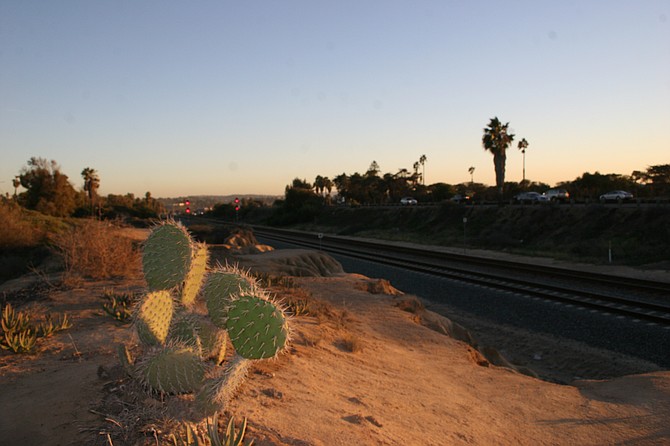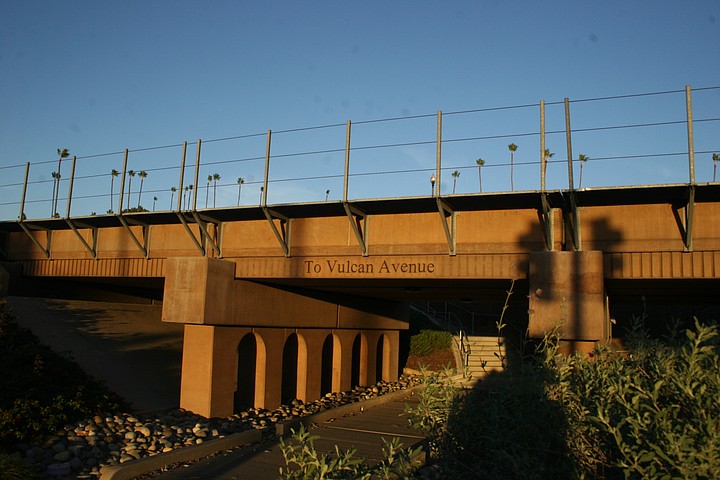 Facebook
Facebook
 X
X
 Instagram
Instagram
 TikTok
TikTok
 Youtube
Youtube

A “frankenstein monster of a concrete path” threatens the coastal community of Cardiff-by-the-Sea in Encinitas, according to No Rail Trail organizer Joe Alkhas.
Plans for a Coastal Rail Trail in Encinitas have inspired more civic discussions than anticipated. The debate centers around the Cardiff segment of the Coastal Rail Corridor planned to extend from Oceanside to downtown San Diego.
The Coastal Rail Trail was first envisaged in the late 1980s. Each coastal city throughout San Diego County, along with the San Diego Association of Governments, will be responsible for construction and maintenance of its respective section of the corridor.
The Cardiff section, which extends from Chesterfield Drive to E Street in downtown Encinitas, is set to be funded by the association of governments: $5.1 million in local TransNet funds and state grants have already been approved. As Joe Alkhas points out, however, the true costs remain unknown.

Alkhas says opposition to the current plan is also voiced by mayor Kristin Gaspar. In May, the Encinitas City Council voted 3-2 for the trail to be located along San Elijo and Vulcan avenues. (Gaspar and councilman Mark Muir voted “no.”)
“This change is significant because although it provides safer access at less cost, federal regulations require more frequent horn-blowing with at-grade crossings,” Mayor Gaspar wrote in a statement about her vote. Future North County Transit District plans to double-track the rail corridor and double the train traffic further complicates the issue, according to the mayor.

The first segment of the corridor project was constructed 15 years ago in Solana Beach. A prominent fence built along that rail track has the No Rail Trail sect concerned about restricted coastal access.
The North County Transit District requires the construction of a fence when any new projects are created along the rail corridor.
To address citizens’ concerns about coastal access in the wake of such a project, a city-council majority approved an at-grade crossing at Montgomery Avenue, where the city had long planned an under-crossing.

Deputy mayor Catherine Blakespear, who supports the establishment of the trail, told the Reader the at-grade crossing was considered because it costs many million dollars less than an under-crossing long planned by the city.
According to Alkhas, the opinions among those in opposition to the Coastal Rail Trail vary.
“If we look at the gradient towards those who would support some sort of trail along the street, I think it is safest to say those people would support something that is more natural,” said Alkhas.
Planning is currently in the engineering and environmental phase, expected to be completed by early 2016. Construction is set to begin in 2017. Despite being approved by the city council, details, designs, and exact costs are yet to be decided upon. What’s been determined heretofore, Alkhas feels, ignored the feelings of the community.
“The city did not hold itself to its own standard for people who want to do a remodel of their own home,” he opined. This has resulted in an uninformed community.
“I understand the Coastal Rail Trail is a part of a multi-billion dollar public works project the corridor from Oceanside to San Diego, but we live in a small community that is already concerned with development, its character and a lifestyle people enjoy here."
Mayor Gaspar concurs: “I do not believe ample community dialogue took place in advance of project approval. This is evidenced by the over 800 emails I have received since the vote was taken, opposing the rail trail project.” Gaspar says she received fewer than a dozen emails in support of the project. She confirms that many of the details of the project remain undecided.
“This project involves [SANDAG], the City of Encinitas, and NCTD,” Gaspar said. “The plan to my knowledge went through preliminary study when SANDAG was going through a vision phase on the project. It is my understanding that SANDAG is currently working to identify what additional work needs to be done in the area of environmental study.”
Blakespear says she has heard from supporters of the trail.
“There are a large number of people who see this as a benefit and would use it,” Blakespear said. “As an example, people say they are happy there will be a legal crossing, because they don’t like to break the rules by crossing the tracks illegally.”
By offering crossings along the railroad, Blakespear says the corridor will reduce the amount of tickets issued by the sheriff's Encinitas office, which has a railroad enforcement team to monitor illegal crossings; many Encinitas residents believe that is overreach.
“There was a lot of sympathy for a woman who got a $500 ticket on her way to work at a Mexican restaurant because she had to cross the tracks to get there,” Blakespear relates. “That’s a lot of money.”


A “frankenstein monster of a concrete path” threatens the coastal community of Cardiff-by-the-Sea in Encinitas, according to No Rail Trail organizer Joe Alkhas.
Plans for a Coastal Rail Trail in Encinitas have inspired more civic discussions than anticipated. The debate centers around the Cardiff segment of the Coastal Rail Corridor planned to extend from Oceanside to downtown San Diego.
The Coastal Rail Trail was first envisaged in the late 1980s. Each coastal city throughout San Diego County, along with the San Diego Association of Governments, will be responsible for construction and maintenance of its respective section of the corridor.
The Cardiff section, which extends from Chesterfield Drive to E Street in downtown Encinitas, is set to be funded by the association of governments: $5.1 million in local TransNet funds and state grants have already been approved. As Joe Alkhas points out, however, the true costs remain unknown.

Alkhas says opposition to the current plan is also voiced by mayor Kristin Gaspar. In May, the Encinitas City Council voted 3-2 for the trail to be located along San Elijo and Vulcan avenues. (Gaspar and councilman Mark Muir voted “no.”)
“This change is significant because although it provides safer access at less cost, federal regulations require more frequent horn-blowing with at-grade crossings,” Mayor Gaspar wrote in a statement about her vote. Future North County Transit District plans to double-track the rail corridor and double the train traffic further complicates the issue, according to the mayor.

The first segment of the corridor project was constructed 15 years ago in Solana Beach. A prominent fence built along that rail track has the No Rail Trail sect concerned about restricted coastal access.
The North County Transit District requires the construction of a fence when any new projects are created along the rail corridor.
To address citizens’ concerns about coastal access in the wake of such a project, a city-council majority approved an at-grade crossing at Montgomery Avenue, where the city had long planned an under-crossing.

Deputy mayor Catherine Blakespear, who supports the establishment of the trail, told the Reader the at-grade crossing was considered because it costs many million dollars less than an under-crossing long planned by the city.
According to Alkhas, the opinions among those in opposition to the Coastal Rail Trail vary.
“If we look at the gradient towards those who would support some sort of trail along the street, I think it is safest to say those people would support something that is more natural,” said Alkhas.
Planning is currently in the engineering and environmental phase, expected to be completed by early 2016. Construction is set to begin in 2017. Despite being approved by the city council, details, designs, and exact costs are yet to be decided upon. What’s been determined heretofore, Alkhas feels, ignored the feelings of the community.
“The city did not hold itself to its own standard for people who want to do a remodel of their own home,” he opined. This has resulted in an uninformed community.
“I understand the Coastal Rail Trail is a part of a multi-billion dollar public works project the corridor from Oceanside to San Diego, but we live in a small community that is already concerned with development, its character and a lifestyle people enjoy here."
Mayor Gaspar concurs: “I do not believe ample community dialogue took place in advance of project approval. This is evidenced by the over 800 emails I have received since the vote was taken, opposing the rail trail project.” Gaspar says she received fewer than a dozen emails in support of the project. She confirms that many of the details of the project remain undecided.
“This project involves [SANDAG], the City of Encinitas, and NCTD,” Gaspar said. “The plan to my knowledge went through preliminary study when SANDAG was going through a vision phase on the project. It is my understanding that SANDAG is currently working to identify what additional work needs to be done in the area of environmental study.”
Blakespear says she has heard from supporters of the trail.
“There are a large number of people who see this as a benefit and would use it,” Blakespear said. “As an example, people say they are happy there will be a legal crossing, because they don’t like to break the rules by crossing the tracks illegally.”
By offering crossings along the railroad, Blakespear says the corridor will reduce the amount of tickets issued by the sheriff's Encinitas office, which has a railroad enforcement team to monitor illegal crossings; many Encinitas residents believe that is overreach.
“There was a lot of sympathy for a woman who got a $500 ticket on her way to work at a Mexican restaurant because she had to cross the tracks to get there,” Blakespear relates. “That’s a lot of money.”
Comments